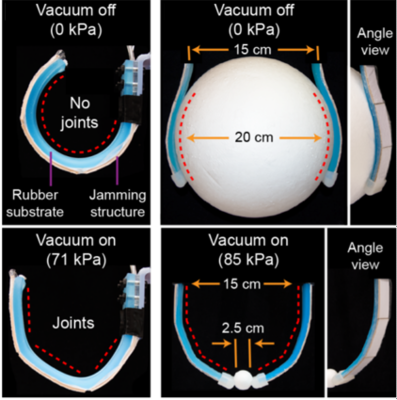 This case study describes the design of a two-fingered grasper that can perform pinch or wrasp grasps, according to the pressure applied in its Laminar Jamming Structures. The work was carried out by Narang, et al (2018A).
This case study describes the design of a two-fingered grasper that can perform pinch or wrasp grasps, according to the pressure applied in its Laminar Jamming Structures. The work was carried out by Narang, et al (2018A).
Objective
In robotic hands, compliant fingers that bend continuously can facilitate wrap grasps around large objects, whereas rigid fingers that bend discretely at joints can facilitate pinch grasps around smaller objects; it is challenging to design and fabricate hands capable of both. To accomplish the task, we built a two-fingered grasper in which each finger consisted of a cable-actuated variable kinematics system with a rounded fingertip.
Design

|
The proposed design is seen in the diagram in the left and is pictured in detail in the right. Three Laminar Jamming Structures are enclosed in an airtight envelope with narrow gaps in betweens them. Each fingertip in the two-fingered grasper has a cylindrical surface with a radius of 5 mm. The fingertips were cast using a two-part mold from PDMS rubber. The airtight envelope is glued to a rubber substrate. A cable is insrted through a channel in the substrate and tied off at the end to a plastic nut. Pulling the cable actuactes the finger.
When no vacuum was applied and the cables were pulled, the device could perform a stable wrap grasp on a ball of diameter 20cm. When vacuum was applied first, the device could perform a stable pinch grasp on a ball of one-eighth the diameter

